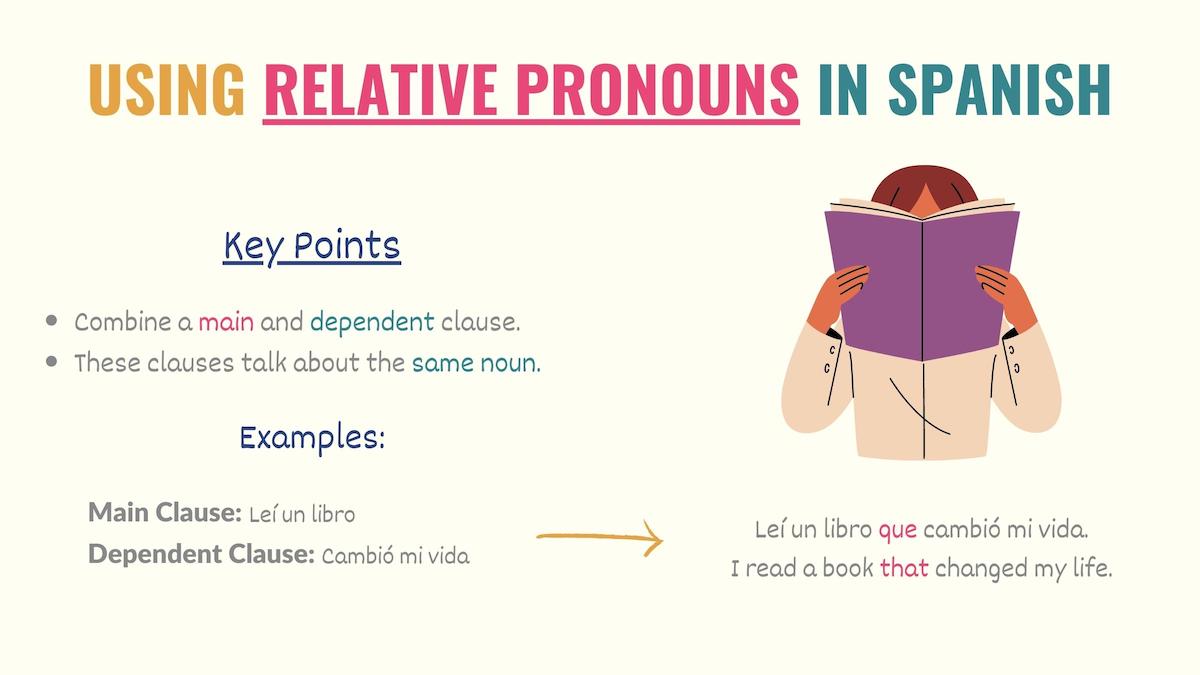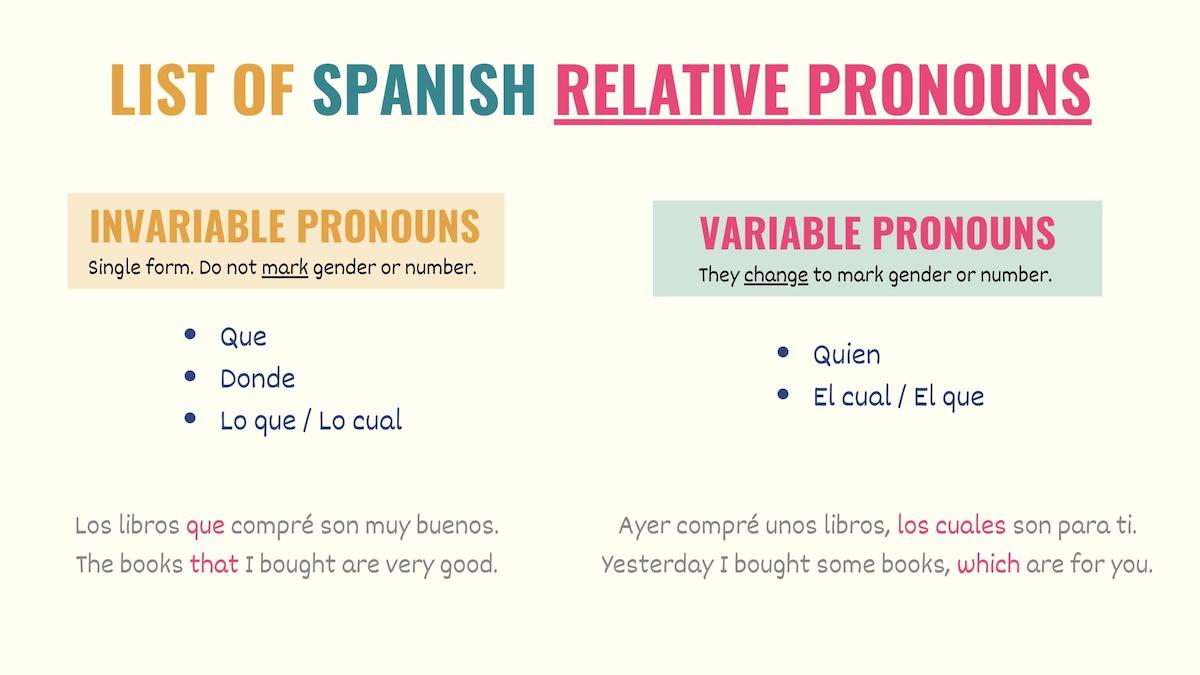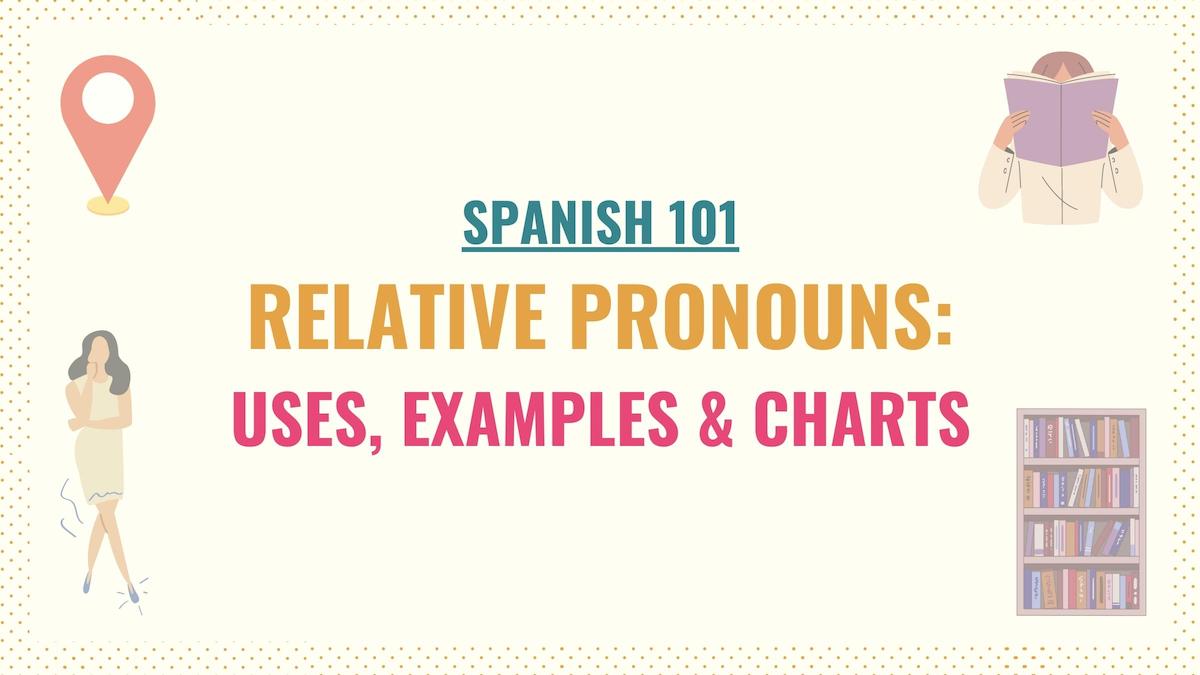Que, lo que, lo cual, and el cual are some examples of Spanish relative pronouns. Since they help you connect sentences while adding more information, relative pronouns in Spanish are crucial to better express your ideas.
However, like other Spanish pronouns, these words follow some specific rules you need to keep in mind. So, in this guide, you’ll find explanations and examples of how and when to use relative pronouns in Spanish. Here’s what we’ll cover:
- What Are Relative Pronouns
- Types of Spanish Relative Pronouns
- Spanish Relative Clauses & Prepositions
- Key Points
- Downloadable PDF
So, let’s get to it.
What Are Relative Pronouns in Spanish
Spanish relative pronouns join two sentences that refer to a noun we mentioned before (antecedent) and don’t want to say again. Check these examples:
| Sentence 1 | Sentence 2 |
|---|---|
| El carro rojo me gusta. I like the red car. | Cuesta muy caro. It’s very expensive. |
| La amiga de hermano es muy amable. My brother’s friend is very nice. | La amiga de mi hermano es doctora. My brother’s friend is a doctor. |
In the sentences above, each pair of sentences refers to the same noun. However, mentioning those nouns again is repetitive and unnecessary. So, we use relative pronouns in Spanish to combine these clauses and avoid duplication:
El carro rojo que me gusta cuesta muy caro.
The red car that I like is very expensive.
La amiga de mi hermano, quien es doctora, es muy amable.
My brother’s friend, who is a doctor, is very nice.

Spanish relative pronouns allow you to join a main sentence with a dependent clause. As we’re about to learn, choosing the correct relative pronoun depends on the noun type or the connection you want to establish.
Take Note: A dependent clause, also called subordinate, provides extra information about the main sentence. Because of this, subordinate clauses cannot stand alone because they wouldn’t provide the sentence’s full meaning.
Types of Spanish Relative Pronouns: When & How to Use Them
In Spanish, there are five relative pronouns. Although they all refer to people, things, actions, or ideas, each relative pronoun can only be combined with certain types of nouns.
Additionally, some relative pronouns in Spanish have a single form (invariable pronouns), whether they’re working with singular or plural nouns. However, others must change to mark the noun’s gender or number (variable pronouns).

Take Note: Relative pronouns are similar to Spanish question words. But unlike interrogative words, these pronouns do not have an accent mark.
Que – That
Que is the most common relative pronoun in Spanish because it can be combined with most nouns. Que refers to concepts, people, things, actions, or animals in singular and plural forms.
Here are some examples:
[Noun] + que + [verb] + [dependent clause]
El teléfono que compré es muy bueno.
The phone that I bought is very good.
La chica que está ahí es mi hermana.
The girl over there is my sister.
Vean la película que les recomendé.
Watch the movie that I recommended to you, guys.
Take Note: Unlike English, relative pronouns in Spanish cannot be omitted.
Quien – Who / Whom
Quien is a formal Spanish relative pronoun that always refers to people. As a result, quien has a plural and singular form. This relative pronoun must be surrounded or preceded by a comma.
[Noun] + [comma] + quien/quienes + [complement]
Luisa, quien era jefa de David, trabaja aquí.
Luisa, who was David’s boss, works here.
Ayer vi a mis primos, quienes se van a mudar a París.
Yesterday I saw my cousins, who are moving to Paris.
Take Note: Relative sentences provide essential information or nonessential information. Nonessential information are extra details that can be omitted and they’re usually surrounded by commas (like the examples above).
El que / El cual – Which / Who
El que and el cual are relative pronouns used to talk about people or things. They mean ‘which’, ‘who’, or ‘whom’. Because they’re built with Spanish definite articles, these pronouns mark gender and number. Here are the different forms you’ll use:
Masculine nouns
- El que / El cual
- Los que / Los cuales
Feminine nouns
- La que / La cual
- Las que / Las cuales
[Main clause] + el cual/el que + [dependent clause]
La camioneta en la que íbamos se descompuso.
The truck which we were in broke down.
En la mesa hay dos collares, los cuales son de tu abuela.
There are two necklaces on the table, which are your grandmother’s.
Take Note: Relative pronouns that are not preceded or surrounded by commas provide essential details to understanding and identifying the noun. For instance, en la que íbamos provides key information about the broken truck.
Lo que / Lo cual – What / Which
Lo cual and lo que are Spanish relative pronouns that refer to statements or ideas. Like other relative pronouns, lo cual refers to a concept or statement mentioned in the main clause:
[Main clause] + comma + lo cual + [dependent clause]
Escuché que estás enojado, lo cual no tiene sentido.
I heard that you’re upset, which doesn’t make sense.
Marco siempre se muerde las uñas, lo cual me parece molesto.
Marco is always biting his nails, which I find annoying.
On the other hand, lo que refers to an implicit statement, concept, or idea that is understood because it was previously discussed:
¿Te acuerdas de lo que te dije el otro día?
Do you remember what I told you the other day?
Ustedes saben qué es lo que me molesta.
You guys know what bothers me.
Donde – Where
In Spanish, the relative pronoun donde is used to refer to places and locations. Donde is an invariable pronoun, meaning that it doesn’t mark gender or number.
[Noun] + donde + [dependent clause]
Este es el lugar donde conocí a tu mamá.
This is the place where I met your mom.
La escuela donde trabajo necesita más maestros.
The school where I work needs more teachers.
This Spanish relative pronoun can be replaced by el que or la que.
Relative Clauses & Spanish Prepositions
Often, Spanish relative pronouns are preceded by a preposition. When a relative clause has a preposition we’re adding information related to destination, origin, company, location, etc. Check these examples:
[Subject] + [preposition] + [relative clause]
Mi amiga, a quien admiro mucho, es doctora.
My friend, to whom I admire so much, is a doctor.
Los chicos con los que trabajamos son muy amables.
The guys with whom we work are very nice.
La casa en la que vivimos actualmente es muy pequeña.
The house in which we currently live is very small.
Combining a preposition with a relative pronoun allows you to add some nuances to your relative clause. Notice that, in Spanish, prepositions must always be placed before the relative pronoun.
Take Note: Cuyo and its plural and feminine forms are relative adjectives. Unlike Spanish relative pronouns, relative adjectives work with a noun instead of replacing it. Luisa, cuya hermana es tu vecina, es mi jefa.
Key Points
Relative pronouns are a type of pronoun that helps you join two clauses together. Here are some key points you should keep in mind:
- Spanish relative pronouns join two clauses that refer to the same noun or pronoun.
- They avoid repetition.
- Relative pronouns in Spanish can be invariable and variable. In other words, some of them only have a single form, while others change to mark gender and number.
- There are five main relative pronouns in Spanish:
- Que: talks about people, things, animals, or concepts.
- Quien: always refers to people and has a plural form.
- El cual / El que: are interchangeable and refer to people or things. They mark the noun’s gender or number through the definite article.
- Lo cual / Lo que: talk about concepts or statements.
- Donde: refers to places and locations.
Download the Relative Pronouns PDF
After learning a Spanish grammar topic such as relative pronouns, it can be tricky to remember all of its rules and types. So, I’ve created a PDF with the rules and examples which you can download for free so you can study and practice this topic whenever you choose.



